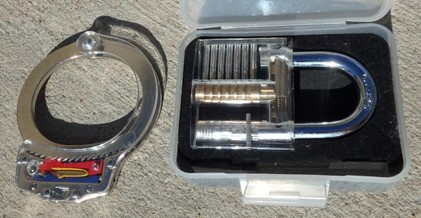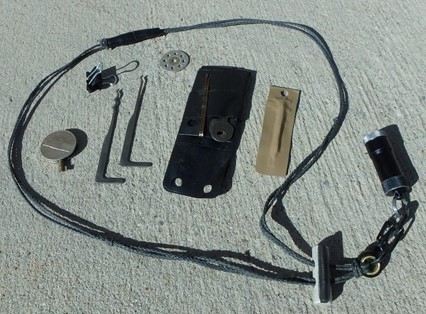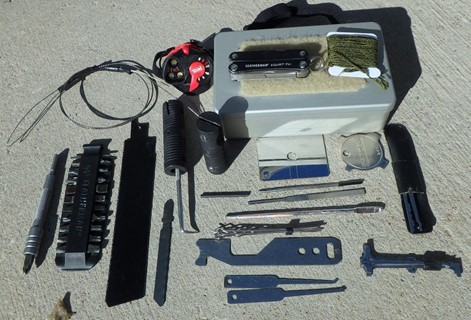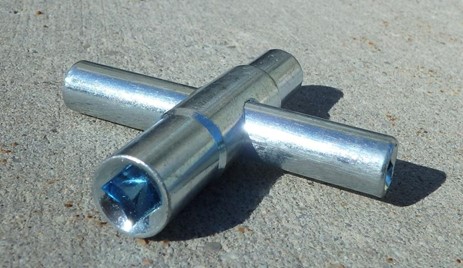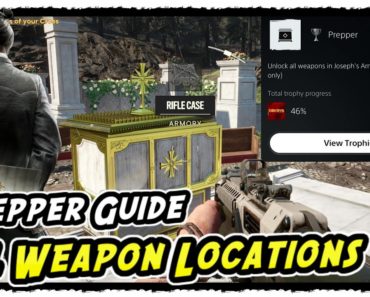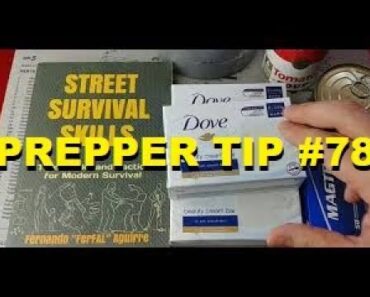Disclaimer – Do not practice on locks that you don’t own or locks on which you rely. Depending how you apply your lock skills, you may earn yourself accolades for getting someone out of a real jam or a one-way trip to the County lockup. The choice is yours. Please consult with an attorney about laws in the jurisdictions you may find yourself in and comply with local laws. While possession of lock tools is legal in many states, laws differ from state to state.
Why lockpicks? In an emergency scenario, why not use forcible entry? Firefighters, Police and Military use them, so shouldn’t survivalists use them too?
I am familiar with this argument and the answer is that I carry both tools for forcible and covert entry. I should be since I hold instructor certifications in high explosive breaching and dynamic entry. I find that carrying both types of tools gives me options and additional versatility. However, your mileage may vary.
Reasons to learn to use and carry covert entry tools:
- Effective physical security requires an understanding of locks and their vulnerabilities. Lockpicking is easy to understand and once you do, you’ll be better able to secure your home, family and property.
- It is often preferable to open a lock without breaking, where possible, so the lock can be used in the future. Not all emergencies are Doomsday scenarios and you may lack the means to repair a lock in such a scenario.
- Seeing evidence of forced entry also causes people to draw their weapons and prepare for a fight, whereas finding everything as they left it puts them at ease.
- Using jiggler keys looks very much like unlocking a lock with a key and is less likely to raise suspicions than breaking in.
- Once you learn the basics of lock picking, you’ll never look at doors the same. Instead of barring your way, all doors are suddenly open to you.
- By opening the lock, you can enter even the most fortified buildings.
- Covert entry is often accomplished with a bare minimum of tools.
- While brute force may gain entry, it won’t get heavy equipment running or make an elevator function but defeating the right locks will.
Training Tip: If you’d like to learn to pick locks, a couple of good resources are TOOoL’s website (The Open Organization of Lockpickers) and Deviant Ollam’s YouTube channel. Their research on handcuff keys helped me perfect my own flat handcuff key design. I recommend purchasing a clear training lock so you can see in inner workings and give it a try. Once you’ve got it down, move on to a real lock. You’ll be opening them in no time.
Modular Survival Entry Kit
These are suggestions for a modular survival entry kit. Since so many of our readers are new to lockpicking, I’ll focus mostly on simple tools that do not require a lot of training to open locks.
Restraint Escape Tools
The first layer of tools I carry are covert restraint escape tools. As the name implies, these tools are concealed and used to escape form restraints such as handcuffs, flex cuffs, rope or duct tape. These tools must be tiny and flat to make them difficult to detected in pat down when concealed in layers of clothing. I avoid carrying restraint escape tools in my wallet because that’s usually the second thing taken in an abduction, right after any weapons. Hiding restraint escape tools in or under valuable (to the assailants) jewelry or watches is also less effective.
I have already written articles on this subject which you can find here: Restraint Escape Kit, Restraint Escape Carry Methods, How to Escape from Handcuffs
Pocket Survival/Self-Recovery Kit
If you read my articles, I hope you carry a pocket survival kit. If you do, many common survival kit components serve double duty as entry tool or can be used to make entry tools from trash laying around anywhere locks are found or you may even considering adding a few entry tools for built environments.
- Leatherman Squirt – Very small multitool with a knife, pliers, wire cutters, two flathead screwdrivers, file and scissors. This little tool is included in some USAF survival kits and is very handy for making entry tools.
- Auto Rockers – A few jiggler keys could be the difference between walking or driving while bugging out, which could also mean the difference between life and death.
- Grips-S Tool Handles – GRIPS-S handles enable me to pack a lot of different tools into a small kit.
- Traveler’s Hook – A favorite tool for manipulating door latches. Sees far more use than my pocket Jim and is used in the same manner as a celluloid or credit card attack, depressing live latches. I am constantly amazed how many doors can be opened with this tool.
- Pocket Jim – For manipulating door latches when the above tool won’t fit. I modified mine to fit the GRIPS-S handles better by flattening the base and adding a hole for the set screw.
- Small Flathead Screwdriver Shank, (2.7mm or smaller) – Use as a screwdriver, Jim, pry tool and can be used with a light hammer to tap out exposed door hinge pins.
- US Issue Spiral Cut Wire Saw Blade – Can be threaded behind live latches protected by plates and pulled from both ends to depress the latch, opening the door. While piano wire is traditionally used in this attack, a wire saw, snare wire or coated knot-able saltwater fishing leader wire is more multi-use and the Grips-S handles can be attached to any of these for additional leverage if needed.
- Lock Pick Set – I modified a cheap set of lockpicks for use with my GRIPS-S handles, but they can be used without them. I’ll go into more detail on picks in the next layer.
- Diamond Cut Off Disc (For rotary tools) – Most useful tool for making high-security handcuff keys or modifying standard keys to open high-security handcuffs. Few other tools are thin enough to cut a 1mm slot in the center of the tooth.
- Diamond Reciprocating Saw Blade – Multipurpose and destructive entry tool. Can be modified as a Jim.
- 22 TPI Carbide Saw Blade – Multipurpose and destructive entry tool.
- Ferro Rod – What on Earth does a ferro rod have to do with lockpicking?! Since it’s the correct diameter, I form sheet metal around it to form the hollow shaft of handcuff keys with a little help from the pliers on the Leatherman Squirt. Any metal rod of the same diameter will work, but many survivalists include a spare ferro rod in pocket survival kits, so I choose a diameter that serves more than one purpose.
- Small Emergency Signal Mirror – The small, metal variety is particularly well suited to use as either an improvised inspection mirror (for finding alarm contacts above doors, booby traps and other surprises) or as a tactical mirror (to peek around corners without exposing yourself to direct fire and minimizing the chance of discovery.)
- Cordage – Car doors with older upright locks (especially the ones with mushroom like buttons on top) can be opened with cordage and it has a lot of other uses.
- LED – It helps to be able to see what you’re doing.
EDC Entry Pouch
I modified a commercial pouch that attaches to a loop field or PALS webbing to either close with a Velcro closure or open and close silently (black pouch in first photo) and I added glow tape to tools that sit behind small tools such as tension tools and picks so I can find the tool I want in the dark.
- Lock Picks – If you are new to lockpicking, there are three basic types of lock tools:
- Rakes – Most lockpickers interested in open locks quickly reach for a rake first. Learning to rake locks is fun and easy and if you haven’t ever opened a lock without a key, you may be surprised what a sense of accomplishment it can give you. As with picks, you don’t need a lot of rakes. The two most important rakes to me are Bogota and wave rakes with 3-5 peaks. Other rakes you may want to include are perhaps a city rake and snake rake, but for survival purposes, if you can’t open a lock quickly, it may be better to move on.
- Turning or Tension Tools – A variety of tension tools is more useful than a variety of picks and rakes since the correct thickness and angle is a big help. In my opinion, the Peterson Pry Bars are fantastic, but it is a simple matter to make your own tension tools just the way you like them.
- Picks – I don’t carry a lot of lock picks and find the half diamond and a medium hooks to be the most useful. A hook pick enables single pin picking of locks that don’t succumb to raking.
- Comb Pick (small four toothed pick) – This is the comb pick you’ll use most often here in the US on low-security solid body master locks and clones. It is used to push the pin stacks above the shear line, opening the padlock.
- Sparrows Orion Tool – Used in the same manner as the two tools above but sized for commercial and government doors. Both the pocket Jim and the Orion are flat and take up little room.
- Bobby Pins (assorted sizes) – I carry these to train others to make picks and tension tools, to make a spare pick set, to make tools I need.
- Warded Picks – Warded locks are common in outdoor settings in North America and warded picks open them just like a key.
- Double-sided Wafer Rakes – Wafer locks are often used on key cabinets, access cabinets, medicine cabinets, file cabinets, storage cabinets, tool cabinets, many older car door locks and some camper shells.
- Padlock Shims – Padlock shims are fitted around the shackle and depressed to separate the locking dogs from the shackle. You can make them from an aluminum can in a pinch.
- EZ Decoder – Looks like the tool below only thinner. Inserted in between dials on combination locks with multiple wheels, they are used to feel when the right number is reached on each wheel.
- Qwik Stick, Shank or Knife Tool – A bypass tool used to reach in through the keyway and open the locking dogs on padlocks.
- Pry Bar – So you aren’t tempted to use your knife to pry.
- Long Nail – A long nail, extra-long pin punch or screwdriver of the appropriate diameter can be used with a hammer (or paperweight) to tap out exposed hinge pins on door that are improperly installed.
Common Keyed Alike Keys – Even if they don’t learn to pick locks or invest in anything else, anybody can toss a small ring of standard keys to common keyed alike locks in their bugout bag. Unlike more advanced lock tools, using these keys doesn’t require specialized training. It is helpful to know which key to try first, but this can also be resolved through trial and error. Despite the simplicity, usefulness and low cost of master keys, I seldom see them included in survival equipment lists for urban areas other than the occasional sill cock key.
I have listed some of the most frequently encountered keyed-alike keys below and will mark the most common keys very common.
- C251A – Used for cam locks on file cabinets, office furniture & cabinets.
- C346A – “
- C390A – “
- C413A – “
- C415A – “
- C420A – “
- C451A – Very common key for cam locks on file cabinets and office furniture, but also used on equipment such as airport jetways.
- C642A – Used for cam locks on file cabinets, office furniture & cabinets.
- CH751 – Very common key for RV compartments (drinking water hoses, generators, deep cycle batteries), cabinets (including key cabinets, push locks, gas pumps (thieves use this key to steal credit card data, but because the money doesn’t come out of the gas station owner’s pocket, they won’t change the locks to protect your data).
- FEO-K1 – Very common fire service elevator key.
- 501CH – Very common key for elevators, tool cabinets (Husky), truck boxes, Siemen’s switches and more. Also known as the CH501.
- Schindler AS100 – Fire service key for Schindler elevators.
- Yale 2642 – Fire service elevator key used in NYC area.
- Ford 1284X – Very common Ford fleet key that will get you into thousands of Crown Victoria police cruisers all over the USA. You may want to check out what police cars, ambulances and taxi cabs are used in your area and pick up the most common fleet keys for them. Other Ford fleet keys are: 1294X, 1435X, 0576X, and 0135X.
- DoorKing 16120 Key – Very common key opens DoorKing building entry system cabinets, enabling you to hit the momentary switch behind the tailpiece of the override lock used for delivering mail or packages.
- Linear A126 Key – Very common key for Linear telephone entry systems, Amigo scooters, electric cabinets, automatic door controls, programmable logic controllers and security gates.
- Linear 222343 Key – Linear telephone entry systems.
- CC1 Club Car Key – Very common. Golf carts & other electric carts.
- Caterpillar 5P8500 Key – Most common key for Caterpillar equipment.
- Sill Cock Keys & Hose Bib Knobs – Access water at freeway rest stops, apartments and commercial properties. Sometimes maintenance personnel simply remove the knob that opens the hose bib and carry it around on a key chain.


